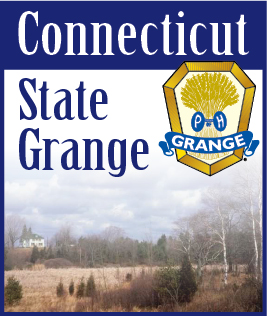| JULY 5, 2010 -- For almost a half-century, members of Tunxis Grange No. 13 have held their meetings in a former one-room schoolhouse at 32 Duncaster Road.
It's a building that Joan Goetjan, a member of the Grange for going on 75 years, knows intimately.
She spent her first four years of schooling at what was then the newly opened Duncaster District School. Years later, she became a regular at the piano or the podium in the building after the Tunxis Grange, then in its 88th year, acquired it from the town in 1963.
[Sample Our Free Breaking News Alert And 3 P.M. News Newsletters]
Back then, it was normal to have 300 people attend a chapter meeting or supper. That Goetjan and the 36 or so remaining members have decided to sell the property signals that the end may soon be near for one of the state's oldest remaining Grange chapters.
It is also another sign that the state's once thriving Grange movement, which began in the 19th century to further the welfare of rural families, is struggling mightily to survive in a world where family farms and sense of community have morphed into insular suburban enclaves and shopping destinations.
The 84-year-old building, now swathed in white vinyl siding, sits on 1.77 acres in a residential zone once dominated by farms and orchards. The town has appraised the parcel at $97,500.
"Some people thought it wasn't a good idea for a Grange to own a building. Now I can see why,'' said Goetjan, laughing as she led her visitors through the front door and into an earlier era.
On the wood-paneled walls hung photographs; the chapter charter, partially wreathed in dark bunting; a framed cursive listing of past masters; and many citations and blue ribbons awarded through the decades. A large map, circa 1970, enumerated the more than 150 Connecticut Grange chapters then in existence. That number today is 62, with a membership totaling less than 4,000, according to Connecticut State Grange President/Master Robert Sendewicz.
Across the worn, hardwood flooring, where Goetjan and her classmates once sat on bolted desks, were several wood podiums, rollers attached, the tops covered with blue, gold-trimmed sashes. A taller lectern beneath two flagpoles displayed a large Bible. Off in one corner, apart from the metal folding chairs and tables, stood the piano that she has played to accompany sing-alongs at the meetings, suppers and other activities.
The chapter voted to sell the property after it couldn't persuade the town, the Wintonbury Historical Society, or the Wintonbury Land Trust - "they don't have any money either" - to take over and maintain the building.
Now 90, Goetjan was the first female master of Tunxis Grange, elected in 1953. Since its founding in 1867, the National Grange was unusual among fraternal orders in that from its inception, women were granted full rights and privileges of membership.
Her husband, Henry, whom Goetjan met at a Grange event, was also a Tunxis master. Her older sister, Phyllis Hocking, who walked to school with her from their farm in what is now Pennwood State Park, about a mile and a half away, was a Granger. Her three sons are still listed on the roster, although she says they are no longer active.
The Tunxis Grange was the center of a community network.
"We used to have a group that worked with the bloodmobile,'' she said. "We were so active. We'd put on a fair every year."
Now, just getting the seven people needed for a meeting quorum is difficult, said Doris T. Shaw, 84, the current master of the Tunxis Grange. It's a difficulty shared by the five other local Granges in Canton, Simsbury, Granby and West Suffield that, with Tunxis, compose the regional Farmington Valley Pomona Grange that Shaw oversees.
"They are not doing well,'' she said. "The attendance of all of them is low."
Despite periodic efforts by the Connecticut State Grange to increase membership and broaden its appeal, the numbers continue to slip.
Sendewicz, said a current membership push is trying to get out the message, particularly to young people, that the organization has long pushed beyond its farm family roots. As a community service organization, open to anyone above the age of 14, it champions food and blood drives, literacy, working with foster families and advocating for issues such as land use and open space preservation.
Still, it's been a hard sell and Sendewicz, a Danbury resident who has been a Grange member since 1978, admits "it's hard to say" whether there will still be a Connecticut Grange in 50 years.
If and when a buyer is found for the Duncaster Road property, the sale must be approved by the board of the State Grange. The proceeds, less $1,000 retained by the local Grange, is held in trust by the state organization.
Without its building, Tunxis Grange No. 13 will retain its identity, as long as it does not surrender its charter. One of the 20 local chapters established in 1875 with the formation of the Connecticut State Grange, it holds the oldest surviving charter.
|
